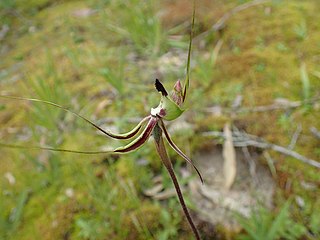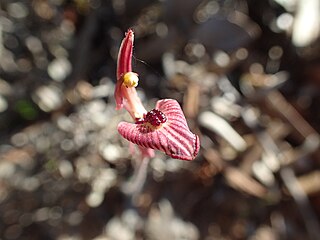
Caladenia paludosa, commonly known as the swamp spider orchid, is a species of orchid endemic to the south-west of Western Australia. It has a single erect, hairy leaf and up to three red, greenish-yellow and cream-coloured flowers. It mostly grows in dense scrub and is one of the last of the similar spider orchids to flower.

Caladenia plicata, commonly known as the crab-lipped spider orchid, is a species of orchid endemic to the south-west of Western Australia. It has a single hairy leaf and one or two red, yellow and pale green flowers with an unusual labellum which vibrates in the slightest breeze.

Caladenia pectinata, commonly known as the king spider orchid is a species of orchid endemic to the south-west of Western Australia. It has a single erect, hairy leaf and up to three large red, yellow and pale green flowers. It is especially common between Bremer Bay and Rocky Gully.

Caladenia dimidia, commonly known as the chameleon orchid is a species of orchid endemic to the south-west of Western Australia. It has a single hairy leaf and one or two yellow, cream-coloured or pinkish flowers. It is a variable species, similar to the Joseph's spider orchid but has a more northerly distribution and smaller flowers.

Caladenia exstans, commonly known as the pointing spider orchid, is a species of orchid endemic to a small area in the south-west of Western Australia. It has a single, hairy leaf and one or two green, yellow and red flowers with a labellum which does not curl downwards but "points" forward.

Caladenia falcata, commonly known as the fringed mantis orchid, is a species of orchid endemic to the south-west of Western Australia. It is a relatively common orchid within its natural range and has a single, hairy leaf and one or two green, yellow and red flowers with spreading petals and upswept lateral sepals.
Caladenia graniticola, commonly known as the Pingaring spider orchid, is a species of orchid endemic to the south-west of Western Australia. It has a single, hairy leaf and one or two yellowish-green, red and white flowers which have a greenish-yellow and white labellum with a red tip. It was originally described as Caladenia hoffmanii subsp. graniticola but has a slightly different labellum and column.
Caladenia hoffmanii, commonly known as Hoffman's spider orchid is a species of orchid endemic to the south-west of Western Australia. It has a single, hairy leaf and one or two, greenish-yellow, red and white flowers which have a greenish-yellow labellum with a red tip. It is distinguished from the Pingaring spider orchid by small differences in the labellum and more northerly distribution.
Caladenia incrassata, commonly known as the puppet clown orchid is a species of orchid endemic to the south-west of Western Australia. It has a single, hairy leaf and usually only one greenish-yellow and red flower which has a red-striped labellum.

Caladenia infundibularis, commonly known as the funnel-web spider orchid is a species of orchid endemic to the south-west of Western Australia. It has a single hairy leaf and up to three greenish-yellow flowers which have a red-tipped labellum.

Caladenia macrostylis, commonly known as the leaping spider orchid, is a species of orchid endemic to the south-west of Western Australia. It has a single, hairy leaf and up to three distinctive pale greenish-yellow and red flowers with a cluster of deep purplish calli in the centre of its labellum.

Caladenia pachychila, commonly known as the dwarf zebra orchid, is a species of orchid endemic to the south-west of Western Australia. It has a single erect, hairy leaf and one or two greenish-yellow and red flowers with a red-striped labellum which has a dense cluster of deep purple calli in its centre. It is similar to the zabra orchid but has smaller flowers and the lateral sepals do not clasp the ovary.

Caladenia pendens subsp. talbotii, commonly known as Talbot's spider orchid, is a plant in the orchid family Orchidaceae and is endemic to the south-west of Western Australia. It has a single hairy leaf and one or two white, red and yellow flowers with long drooping petals and sepals and sometimes has a citrus-like scent.

Caladenia rhomboidiformis, commonly known as the diamond spider orchid, is a species of orchid endemic to the south-west of Western Australia. It has a single erect, hairy leaf and one or two green, yellow and red flowers. Until 1971 It was known as a variety of the green comb spider orchid Caladenia dilatata then, until 1989 as a variety of the clubbed spider orchid, Caladenia longiclavata.
Caladenia richardsiorum, commonly known as the little dip spider orchid, Richards' spider orchid or robe spider orchid, is a plant in the orchid family Orchidaceae and is endemic to South Australia. It is a ground orchid with a single erect, hairy leaf and usually only one yellowish-green flower. It is similar to the endangered Mellblom's spider orchid but has a much larger leaf and the petals lack glandular tips.

Caladenia verrucosa, commonly known as the mallee spider orchid, is a plant in the orchid family Orchidaceae and is endemic to south-eastern Australia. It is a ground orchid with a single, hairy leaf and usually only one greenish-yellow and red flower.
Caladenia saxicola, commonly known as the banded ironstone spider orchid is a plant in the orchid family Orchidaceae and is endemic to the south-west of Western Australia. It has a single erect, hairy leaf and one or two dull creamy-white to pale yellow flowers with spreading lateral sepals and petals.

Caladenia septuosa, commonly known as the Koppio spider orchid, is a plant in the orchid family Orchidaceae and is endemic to South Australia. It is a ground orchid with a single erect, sparsely hairy leaf and usually only one greenish-cream flower with red stripes along the sepals and petals.
Caladenia stellata, commonly known as the starry spider orchid is a plant in the orchid family Orchidaceae and is endemic to south-eastern Australia. It is a ground orchid with a single, hairy leaf and usually only one greenish-cream flower with red markings.
Caladenia voigtii, commonly known as the mohawk orchid, is a species of orchid endemic to the south-west of Western Australia. It has a single erect, hairy leaf and usually only one greenish-yellow and red flower. When discovered near Salmon Gums in 1977, it was thought to be the extinct Caladenia cristata, but when C. cristata was found near Miling, the Salmon Gums discovery was renamed C. voigtii.














